
|
|
|
Happy 8th Anniversary HGCNY!
|
Photo: Trillium 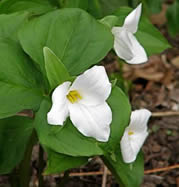 | | Habitat Gardening in Central New York held its first meeting in March
2002.
Many thanks to my co-founders Michelle Welcher and Dan Carroll, who
provided the organizational know-how and the natural landscaping
know-how to get us started off on the right track!
Back then, we were called the "Habitat Gardening Club" and described ourselves as "a gardening club with a difference"!
Thinking about this a little more, we changed our name to Habitat Gardening of Central New York, dropping the "Club." Why? Because we really aren't a garden club, which typically has a members-only meeting, and, for some garden clubs, a more specifically socializing focus. Instead, we're an education and advocacy group, and our meetings are free and open to the public.
Thinking about our name still more, we made a subtle change to "Habitat Gardening in Central New York," changing the "of" to "in." A small change in wording, but it means we're doing our gardening IN central New York, rather than being an organization that happens to reside in CNY. This is an important difference, since we're all about native plants in our region!
After a few years, we became a chapter of the national education and advocacy organization Wild Ones: Native Plants, Natural Landscapes, an organization that's consistent with our mission. It's great to be part of a larger national effort to preserve biodiversity by planting native plants. You can help celebrate our anniversary by becoming an official Wild Ones/HGCNY member and renewing your membership when it comes due.
|
CNY garden featured in Nature's Garden magazine!
|
Nature's Garden
Summer 2010 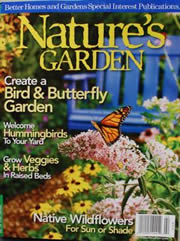 | | At long last, after having photos taken in the summer of 2008, the article on my habitat garden has finally appeared in the Summer 2010 issue of Nature's Garden, a Better Homes and Gardens Special Interest publication. 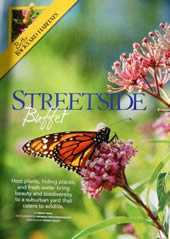 "Streetside Buffet" article: Photo of a monarch on a swamp milkweed in my yard "Streetside Buffet" article: Photo of a monarch on a swamp milkweed in my yard |
|
Greetings!
Though relatively common in Central New York, the black walnut tree produces a nut with uncommonly good taste. D. Andrew Saunders, a professor at State College of Environmental Science and Forestry in Syracuse, will present a program on the tree, "Going Nuts, Interpreting the Natural History of the Black Walnut."
 WHEN: Sunday March 28 at 2:00 pm WHEN: Sunday March 28 at 2:00 pm
WHERE: Le Moyne College Library Special Activity Room (Directions)
Our meetings are free and open to the public. Come and bring a friend!
~~~~~~~ The Buzz on Bees ~~~~~~~
 I'll be giving a presentation on bees and other pollinators immediately before the Edible Gardening CNY meeting on Saturday March 27 at 1:00 pm at Liverpool Library. I'll be talking about why they're important and how to help these beneficial creatures. It's free and open to the public. I'll be giving a presentation on bees and other pollinators immediately before the Edible Gardening CNY meeting on Saturday March 27 at 1:00 pm at Liverpool Library. I'll be talking about why they're important and how to help these beneficial creatures. It's free and open to the public.
And if you want to learn more about growing fruits and vegetables, you're welcome to stay for the EGCNY meeting, too - also free and open to the public - starting at 2:00 pm in the same location.
Janet Allen, President
Habitat Gardening in Central New York
|
|
Emergency! Critical need for milkweed this year!
Monarch egg on small milkweed plant 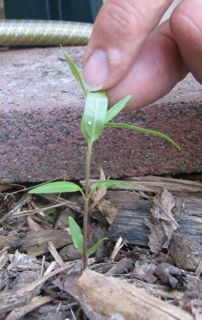 | Here is some of the sad news from the world's leading monarch butterfly experts, as reported on Journey North. Dr. Lincoln Brower, preeminent monarch specialist in the world, said, "It is likely that the original 1.92 hectares [less than 5 acres] of monarchs has been reduced by at least 50%. We hope that what will be the all time historical low number of surviving butterflies will meet good weather conditions when they fly into Texas to reestablish the new spring generation at the end March and early April." Dr. Chip Taylor of Monarch Watch says, "We have no prior experience with such a small returning population and it is uncertain whether monarchs in such numbers could recover in one year." He added, "My thinking now is that it will take monarchs at least two, and perhaps more, years to recover from the effects of the last breeding season and the winter of 2009-2010." Monarch biologist Dr. Bill Calvert says recovery of the population depends on factors such as "temperatures and moisture in the breeding zones, the consequent conditions of the monarch food plant, the population levels of monarch parasites and predators--too many unknowns to predict with any certainty." The Bottom LineMonarchs have always needed milkweed, but this year more than ever if the population is to recover. FREE Milkweed seeds!I'll have free milkweed seeds ( Asclepias incarnata and A. tuberosa) available at Saturday's pollinator presentation and at our Sunday meeting. Plant some this year! It's a little late but even if they don't reach full size very  soon, they're still valuable. Monarch caterpillars only need the leaves to eat, so the adults will lay eggs even on small plants. And since they're perennials, you'll be all set for next year.
PHOTO: Note the small white dot, which is the monarch's egg, on this very small plant.
To read more about the situation:Storms threaten monarchs' winter rest in Mexico |
|
The Candle Plant
PHOTO: Bayberry berries 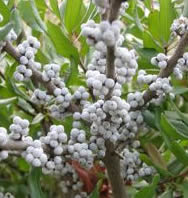 | Everyone knows about bayberry candles, but did you know where they get the wax to make those fragrant candles? From our native bayberry (Myrica pensylvanica). [Note: We're talking about bayberry,
not barberry.] Bayberry is a member of the laural family, so it's not surprising that
the colonists used the leaves as a bay laurel substitute in cooking.
I've never tried making candles from the waxy coating on the berries, but I enjoy watching the chickadees and catbirds eat them through the winter and early summer. I also like to crush a few leaves as I walk by just to enjoy the fragrance. Another interesting feature of this plant is that it's nitrogen-fixing, so it grows well in poor soil.
Bayberry is relatively easy to find in garden centers. One thing to note, though, is that it's one of those shrubs that comes in male and female plants (called "dioecious"). Only one male is needed to ensure that five or so females have lots of berries. The problem is that nurseries don't generally label them as male or female. You can either take your chances or buy them in the late summer or fall when you can see which ones have berries.
I like the looks of the plant. William Cullina, in his book Native Trees, Shrubs, and Vines, describes them as growing in "billowing mounds." I've always thought of them as "fluffy," and I find the dark green, leathery leaves to be very attractive.
Sweet gale (M. gale) is a smaller relative.
SOIL: Dry to wet, well-drained; prefers acidic
LIGHT: Sun to partial shade
SIZE: About 2-8 ft high and wider
Easy to care for and makes a great hedge!
|
|
|
Citizen science projects
Lemon Queen sunflower 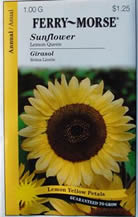 |
Great Sunflower Project Update: In our March 10 newsletter (if you weren't on our list yet, you can find it in the archive), we mentioned planting 'Lemon Queen' sunflowers, a cultivar of the native sunflower (Helianthus annuus). I've since found the seeds at Lowe's (see photo).
Project Budburst:
Spring is busting out all over, so it's a good time to start participating in Project Budburst, where you can share your observations of phenophases such as the first leaf, first bud, etc. This project will help track plants' response to the changing climate. Got kids? Check out Budburst Buddies.
NestWatch:
As you've probably heard from all the twitterings in your yard, birds are preparing to nest. Help collect information on their nesting this year with Cornell Lab of Ornithology's Nest Watch.
|
|
|
|
|